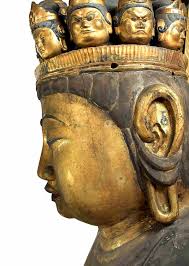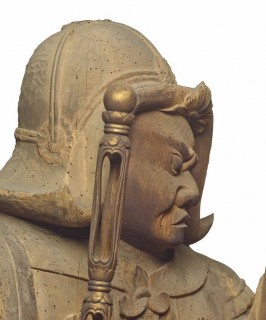Loading
Search
▼ Treasures of ‘Hidden Village’ Revealed
- Category:Tourism
Nara and Kyoto are famous for their abundance of valuable Buddhist statues, but Shiga Prefecture, too, boasts its own share of such important cultural properties. Part of those treasures are on view at the exhibition
“The Hidden Buddha of Rakuyaji Temple, Shiga” at the Tokyo National Museum in Ueno Park, Tokyo, where visitors can get a glimpse of the temple’s collection of Heian period (794-late 12th century) Buddhist statues for the first time outside the temple’s grounds.
Rakuyaji is an old Buddhist temple located in Koka, Shiga Prefecture. According to legend, it was built after Saicho, the founder of the Tendai sect, came to the area in 792 and sculpted a Buddhist statue from a yew tree. Saicho was there, the legend has it, in search of good timber to build Enryakuji temple on Mt. Hiei in present-day Otsu.
The Seated Eleven-Headed Kannon Bosatsu (Ekadasamukha) — Rakuyaji’s principle icon — on display at the Ueno exhibition was not made by Saicho. It was made later, in the 10th century, out of Japanese cypress.
I assume the legend of Saicho being where Rakuyaji would later be built came from the fact that the area is near the Suzuka Mountains, where timber was collected to build Todaiji temple in Nara.
Rakuyaji has long been well known among devotees of Buddhist statues, if not among tourists.
The temple possesses 20 important cultural properties, all Buddhist statues. While Shiga Prefecture has a number of such statues, it is extremely rare to have a collection of such volume in one place.
The exhibition marks the first time that all of the temple’s 20 Heian period sculptures are being exhibited together outside the temple’s grounds.
The highlight of the exhibit is the Seated Eleven-Headed Kannon Bosatsu, usually placed in a huge zushi, a special cabinet to hold Buddhist items.
The statue, which is more than 5 meters tall including its halo and pedestal, is overwhelming. It is incredible that the figure — from head to torso — was carved from a single tree.
“The Hidden Buddha of Rakuyaji Temple, Shiga” at the Tokyo National Museum in Ueno Park, Tokyo, where visitors can get a glimpse of the temple’s collection of Heian period (794-late 12th century) Buddhist statues for the first time outside the temple’s grounds.
Rakuyaji is an old Buddhist temple located in Koka, Shiga Prefecture. According to legend, it was built after Saicho, the founder of the Tendai sect, came to the area in 792 and sculpted a Buddhist statue from a yew tree. Saicho was there, the legend has it, in search of good timber to build Enryakuji temple on Mt. Hiei in present-day Otsu.
The Seated Eleven-Headed Kannon Bosatsu (Ekadasamukha) — Rakuyaji’s principle icon — on display at the Ueno exhibition was not made by Saicho. It was made later, in the 10th century, out of Japanese cypress.
I assume the legend of Saicho being where Rakuyaji would later be built came from the fact that the area is near the Suzuka Mountains, where timber was collected to build Todaiji temple in Nara.
Rakuyaji has long been well known among devotees of Buddhist statues, if not among tourists.
The temple possesses 20 important cultural properties, all Buddhist statues. While Shiga Prefecture has a number of such statues, it is extremely rare to have a collection of such volume in one place.
The exhibition marks the first time that all of the temple’s 20 Heian period sculptures are being exhibited together outside the temple’s grounds.
The highlight of the exhibit is the Seated Eleven-Headed Kannon Bosatsu, usually placed in a huge zushi, a special cabinet to hold Buddhist items.
The statue, which is more than 5 meters tall including its halo and pedestal, is overwhelming. It is incredible that the figure — from head to torso — was carved from a single tree.
Also among the must-sees are the Seated Yakushi Nyorai (Bhaisajyaguru), the Seated Jizo Bosatsu (Ksitigarbha) and the Standing Bishamonten (Vaisravana) statues. The Seated Jizo Bosatsu was completed in 1187 after thousands of people made donations for its creation. The Standing Bishamonten is said to have been dedicated by Sakanoue no Tamuramaro, a Heian period general, praying in honor of his victory in battle.
The 20 statues can be placed in two groups: those created from the 10th to the first half of the 11th centuries and those created from the latter half of the 11th to the 12th centuries.
The earlier group, which includes the Seated Eleven-Headed Kannon Bosatsu, has orthodox graceful appearances with small eyes slanting upward. The statues in standing poses are fascinating. The later works are more or less plain, though they certainly convey the pious feelings of followers.
Essayist Masako Shirasu (1910-1998) once mentioned Rakuyaji in her book “Kakure-zato” (Hidden village), which describes hidden locations, forgotten somewheres away from the beaten path.
I would say that the Buddhist statues of Rakuyaji are definitely hidden treasures from the past.
Shiro Maruyama is senior manager of the Special Exhibition Planning, Curatorial Planning Dept. of the Tokyo National Museum and the chief curator for this exhibition.
“The Hidden Buddha of Rakukyaji Temple, Shiga” is on view through Dec. 11. Visit: http://hibutsu2016.com/english.html
The 20 statues can be placed in two groups: those created from the 10th to the first half of the 11th centuries and those created from the latter half of the 11th to the 12th centuries.
The earlier group, which includes the Seated Eleven-Headed Kannon Bosatsu, has orthodox graceful appearances with small eyes slanting upward. The statues in standing poses are fascinating. The later works are more or less plain, though they certainly convey the pious feelings of followers.
Essayist Masako Shirasu (1910-1998) once mentioned Rakuyaji in her book “Kakure-zato” (Hidden village), which describes hidden locations, forgotten somewheres away from the beaten path.
I would say that the Buddhist statues of Rakuyaji are definitely hidden treasures from the past.
Shiro Maruyama is senior manager of the Special Exhibition Planning, Curatorial Planning Dept. of the Tokyo National Museum and the chief curator for this exhibition.
“The Hidden Buddha of Rakukyaji Temple, Shiga” is on view through Dec. 11. Visit: http://hibutsu2016.com/english.html
- October 22, 2016
- Comment (0)
- Trackback(0)



